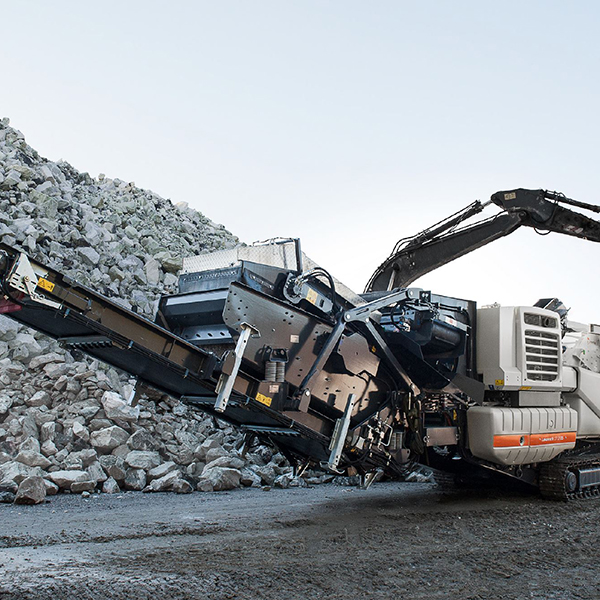Whether you want to buy or rent a rock crusher, choosing the right one is imperative to the success of your project. The machine should be powerful enough to handle your needs but not too powerful for your budget. Here are a few factors to consider:
Crushing Stage
Rock crushing consists of three stages: primary, secondary, and tertiary. In the primary phase, large pieces of rock get broken down into smaller sizes to be fed into other crushers to reduce their size even further.
Large-capacity crushers that can handle more sizable feed materials are typically used in this stage. In the secondary and tertiary stages, the feed material’s size is progressively reduced until the output is the desired size.
Material Composition
Once you have determined the crushing stage, consider the composition of the material you will be crushing. The type of crusher you need will differ based on the feed material.
For example, for harder rocks, like granite or basalt, you’ll need powerful equipment like jaw crushers. On the other hand, if you’re working with softer limestone or sandstone, you can use impact crushers.
Feed and Output Material Size
The size of your feed material and the desired output is something else you should consider. Crushers come in different sizes and, as a result, can handle different-sized inputs. Large input materials will require larger rock crushers.
Likewise, if you want a very fine output, you will need a crusher that breaks down the input to that size. Remember that if you start with large rocks and need to reduce them to the consistency of something as small as sand, you’ll probably need to go through multiple crushing stages.
Production Rate
Production rate measures throughput, which essentially means the total amount of material the machine can process per hour. Like the reduction rate, the higher the production rate a crusher has, the more efficient it will be.
However, it’ll also be more expensive, so if you don’t have a large volume of input material to process per hour, then a machine with a lower production rate might be a better choice.
Reduction Rate
The reduction rate refers to how much the crusher can reduce the size of the input material. Most common rock crushers have reduction ratios ranging from 2:1 to 10:1, meaning they can reduce the material to as little as a tenth of its original size.
The higher the reduction rate of the rock crusher, the more efficient it is. However, if you want to rent a rock crusher and don’t need your output to be as small, a lower reduction rate might be a more cost-effective option.
Types of Crushers
Now that you better understand the factors to consider when selecting a rock crusher, here is an overview of the different types of crushers:
Compression Crushers
As the name suggests, a compression crusher breaks down material by compressing it between two surfaces. They generate massive force, meaning they can handle various materials, including granite. Commonly used compression crushers include jaw and cone crushers.
Impact Crushers
An impact crusher uses high-speed impact to break down the material, such as by striking it with a hammer. While these crushers have a high reduction rate, they are best suited for softer and nonabrasive materials such as limestone, sandstone, and coal due to how they crush material.
Setup Configurations
Depending on the size and complexity of your project, you may need different configurations of crushers. Rock crushers are often combined with other elements, such as feeders and conveyors. They are then mounted on a frame to create a single unit, which can be stationary or modular, mobile on tracks, or portable on wheels.
Stationary/Modular Plants
A stationary or modular plant is usually the best choice for larger mining operations where it will spend its entire life span without moving. However, this type of plant usually has a large footprint and needs significant infrastructure, such as walls, pads, and ramps, to support the equipment.
Stationary plants are also completely immobile, which becomes a problem as the source of the material moves further away from the original site. The result is increased fuel consumption and wear and tear on all the equipment needed to transport the rock.
Mobile/Portable Plants
A mobile or portable plant is more suitable for smaller operations without investing in a permanent setup. Tracked or wheeled configurations are available, each of which can be moved to different locations as needed.
A portable rock crusher is mounted on wheels, and while it might seem like the best option for mobility, these units often take longer to set up than their tracked counterparts.
A tracked rock crusher is self-contained and can get to work in minutes. On the other hand, wheeled rock crushers can take hours or even days because they need to be anchored and connected to external power sources, among other things.
Contact Mellott for Expert Assistance When Choosing a Rock Crusher
Whether you plan to buy or rent a rock crusher, choosing the right one can significantly impact your project. To make the best decision, consider factors such as reduction rate, production rate, types of crushers available, and setup configurations.
If you’re still unsure which rock crusher is best suited for your project, contact Mellott. Our experienced team of aggregate production experts will help you determine the ideal rock crusher and setup configuration for your operations. Contact us today to learn more.

